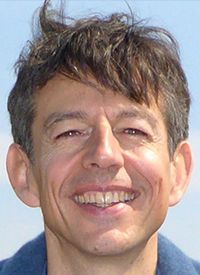Tazemetostat Active in Follicular Lymphoma, DLBCL
Tazemetostat (EPZ-6438) demonstrated strong clinical activity in patients with advanced EZH2-mutated follicular lymphoma, and was also active in patients with diffuse large B-cell lymphoma.
Franck Morschhauser MD, PhD

Franck Morschhauser MD, PhD
Tazemetostat (EPZ-6438) demonstrated strong clinical activity in patients with advanced EZH2-mutated (EZH2m) follicular lymphoma, and was also active in patients with diffuse large B-cell lymphoma (DLBCL).
In interim phase II study results presented at the 2017 International Conference on Malignant Lymphoma (ICML) biennial meeting in Lugano, Switzerland, tazemetostat induced an objective response rate (ORR) of 92% in patients with EZH2m follicular lymphoma and 26% in patients with EZH2 wild-type follicular lymphoma.
ORR was 29% in patients with EZH2-mutated DLBCL and 15% in those with EZH2 wild-type DLBCL.
Tazemetostat is an oral, first-in-class small molecule EZH2 inhibitor for the treatment of multiple types of hematological malignancies and genetically defined solid tumors. The drug targets histone methylation in lymphoma.
“Activating mutations can act as an oncogenic driver, especially in follicular lymphoma and germinal center B-cell—like (GCB) DLBCL and are present in approximately 20% of patients,” said lead author Franck Morschhauser MD, PhD, Hôpital Claude Huriez in Lille, France. “These preliminary findings suggest that continued tazemetostat treatment has the potential to translate into tumor regression over a prolonged period of time.”
Morschhauser presented interim efficacy and safety data from an open-label, multicenter, ongoing phase II study of tazemetostat as monotherapy in patients with relapsed or refractory follicular lymphoma and DLBCL. Investigators prospectively stratified patients by EZH2 mutational status and cell of origin:
- EZH2m DLBCL (n = 17)
- EZH2 wild-type DLBCL (n = 119)
- EZH2 m follicular lymphoma (n = 13)
- EZH2 wild-type follicular lymphoma (n = 54)
All patients received 800 mg daily of oral tazemetostat. This year, investigators added another cohort of patients with DLBCL assigned to the combination of tazemetostat and prednisolone.
As of June 1, 2017, 210 patients were evaluable for safety and 203 for efficacy. Morschhauser pointed out that patients with follicular lymphoma had received a median of 4 prior treatment lines and patients with DLBCL had received a median of 3 prior lines of therapy.
Complete response rate was 0% in the EZH2 m DLBCL cohort, 8% in the EZH2 wild-type DLBCL cohort, 8% in the EZH2m follicular lymphoma cohort, and 6% in the EZH2 wild-type follicular lymphoma cohort. Partial response rates were 29%, 8%, 85%, and 20%, respectively.
No patient with EZH2m tumors experienced progressive disease. In both EZH2 m cohorts, 48% of patients with follicular lymphoma and 12% of patients with DLBCL remain on study with stable disease.
Overall, 75% of patients with follicular lymphoma had reduced tumor burden.
The time to first response was highly variable, ranging from 4.6 weeks to 48.1 weeks across all cohorts.
“Due to the variability of time to response, we are continuing to monitor patients for possible late response and possible conversions from partial to complete response in both subtypes,” said Morschhauser.
The safety analysis revealed that all-grade treatment-emergent adverse events (AEs) occurred in 90% of patients and grade ≥3 treatment-related AEs occurred in 59%. The most common grade ≥3 treatment-related AEs were thrombocytopenia and neutropenia, each reported in 6% of patients, and anemia in 4%.
Ten percent of patients experienced serious treatment-related AEs, and 15% of patients had a treatment-related AE that led to dose interruption. Treatment-emergent AEs lead to dose reductions in 3% of patients and to discontinuation or withdrawal for 2% of patients.
The protocol specifically outlined molecular characterization of patients by prospective testing using the cobas® EZH2 Mutation Test (Roche) and an allele specific PCR test for EZH2 hot-spot mutations plus retrospective testing using next generation sequencing (NGS) on archival and circulating DNA and the Lymph2Cx nanoString assay. Hans immunohistochemistry was done to determine the cell of origin in DLBCL cases only.
“Detection of EZH2 mutation is ctDNA [circulating tumor] indicates potential for future use of plasma for identification of patients likely to respond to tazemetostat,” Morschhauser said.
This molecular profiling identified EZH2 and MYD88 activating mutations as putative positive predictors of tazemetostat response, whereas MYC, TP53 and HIST1H1E were determined to be negative predictors of response.
“This study demonstrates the value of evaluating the mutation status—in this trial, knowledge of the mutation status made a real difference and opens the way for further studies,” said session discussant Thomas E. Witzig, MD, deputy director for clinical and translational research at the Mayo Clinic in Rochester, Minnesota. “The important aspect of this study is that it proves that methylation is a relevant target and demonstrated tazemetostat results that are relevant to practice.”
In April 2017, the FDA granted fast track designation to tazemetostat for both relapsed/refractory follicular lymphoma with or without an EZH2 activating mutation, and DLBCL with EZH2 activating mutations.
Morschhauser F, Salles G, McKay P, et al. Interim report from a phase 2 multicenter study of tazemetostat, an EZH2 inhibitor, in patients with relapsed or refractory B-cell non-Hodgkin lymphomas. Hematol Oncol. [published online June 7, 2017] 35, 2017 (suppl S2; abst 4). doi: 10.1002/hon.2437_3.



